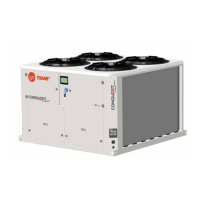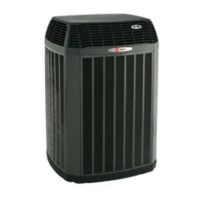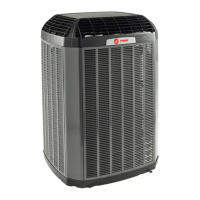Do you have a question about the Trane CGA Series and is the answer not in the manual?
Explains warranty terms, conditions, and voidance criteria for the unit.
Details procedures for checking units upon delivery for damage or missing parts.
Describes factory inspection processes and conditions for performance testing.
Outlines uses that are not intended and could compromise safety or performance.
Explains the meaning of various safety symbols and warning labels used in the manual.
Lists applicable directives and standards for the unit's design and manufacturing.
Details the certifications and approvals obtained by the unit from notified bodies.
Defines key roles and responsibilities such as Owner, Installer, Operator, and Technician.
Provides guidance on safely accessing hazardous areas within the unit and necessary precautions.
General safety advice to be followed when working with or around the unit.
Instructions and precautions for safely lifting, moving, and placing the unit in its final location.
Advises on avoiding obstacles and managing wind effects on unit performance.
Explains how direct sun exposure can affect unit operation and cause shutdowns.
Recommends avoiding installation near exhaust fumes or heat sources.
Advises against installing near plants that could obstruct airflow.
Details how to manage compressor securing mechanisms for vibration isolation.
Specifies requirements for the mains power supply voltage and phase balance.
Outlines procedures for connecting the unit's power supply circuit safely and compliantly.
Warns against operating with voltage phase unbalance exceeding 3% and its warranty implications.
Explains harmonic distortion (THD) and its impact on power supply and unit operation.
Lists required components and considerations for the evaporator's water circuit installation.
Details installation procedures and conditions for the condenser's water piping.
Provides formulas for calculating required water content and flow rates for optimal operation.
Describes essential components for regulating the water circuit, like pumps and valves.
Illustrates the basic hydraulic circuit layout with component labeling.
Shows the hydraulic circuit for a specific version with one water pump.
Depicts the hydraulic circuit for a version with a water pump and built-in water tank.
Essential checks to perform on connected machinery and unit components before starting.
Procedures for checking refrigerant leaks and dehydrating the system using vacuum.
Methods for verifying correct refrigerant charge by observing sight glass bubbles.
Pre-operation checks including mechanical tightness and oil heater insertion.
Steps to initiate the unit's operation and initial checks on rotation and controls.
Procedure to bring the plant to the correct operating temperature before releasing cooling.
Instructions on checking and adjusting the compressor oil level using the sight glass.
Details the 220V power supply for the auxiliary circuit and connected components.











